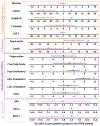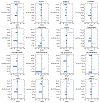Associations of per- and polyfluoroalkyl substances with maternal metabolic and inflammatory biomarkers in early-to-mid-pregnancy
- PMID: 38346483
- PMCID: PMC11102845
- DOI: 10.1016/j.envres.2024.118434
Associations of per- and polyfluoroalkyl substances with maternal metabolic and inflammatory biomarkers in early-to-mid-pregnancy
Abstract
Background: Per- and polyfluoroalkyl substances (PFAS) can disrupt metabolism. Early-to-mid pregnancy is characterized by amplified metabolic processes and inflammation to support maternal adaptations and fetal growth. Thus, we cross-sectionally evaluated whether PFAS are individually and jointly associated with these processes in early-to-mid pregnancy.
Methods: Pregnant Illinois women (n = 452) provided fasted blood samples at median 17 weeks gestation. We quantified serum perfluorononanoic (PFNA), perfluorooctane sulfonic (PFOS), perfluorooctanoic (PFOA), methyl-perfluorooctane sulfonamide acetic acid (Me-PFOSA-AcOH), perfluorohexanesulfonic (PFHxS), perfluorodecanoic (PFDeA), and perfluoroundecanoic (PFUdA) acid. Key outcomes were plasma glucose, insulin, C-peptide, insulin-like growth factor 1 (IGF-1), adiponectin, leptin, triglycerides, free fatty acids, total cholesterol, high-density lipoprotein (HDL) cholesterol, C-reactive protein, tumor necrosis factor alpha (TNF-α), monocyte chemoattractant protein-1 (MCP-1), and interleukin 6. We calculated homeostatic model assessment for insulin resistance (HOMA-IR), low-density lipoprotein (LDL) cholesterol, and very low-density lipoprotein (VLDL). We evaluated associations of PFAS with each metabolic/inflammatory biomarker individually using covariate-adjusted linear regression and jointly using quantile-based g-computation.
Results: In linear regression, all PFAS (except Me-PFOSA-AcOH) were negatively associated with insulin, HOMA-IR, and leptin, whereas all PFAS were positively associated with HDL cholesterol. We also observed negative associations of some PFAS with TNF-α and MCP-1; positive associations with adiponectin and total cholesterol also emerged. Additionally, PFOS was positively, whereas Me-PFOSA-AcOH was negatively, associated with triglycerides and VLDL. Each 25% increase in the PFAS mixture was associated with -31.3% lower insulin (95%CI: -45.8, -12.9), -31.9% lower HOMA-IR (95%CI: -46.4, -13.4), and -9.4% lower leptin (95%CI: -17.3, -0.8), but 7.4% higher HDL cholesterol (95%CI: 4.6, 10.3). For most outcomes, the major contributors to the PFAS mixture often differed compared to single-PFAS analyses.
Implications: Individual and joint PFAS exposures were associated with markers of maternal metabolism and inflammation in pregnancy. Further investigation is needed to elucidate possible mechanisms and consequences of these findings.
Keywords: Inflammation; Metabolism; Mixtures; PFAS; Pregnancy.
Copyright © 2024 The Authors. Published by Elsevier Inc. All rights reserved.
Conflict of interest statement
Declaration of competing interest The authors declare that they have no known competing financial interests or personal relationships that could have appeared to influence the work reported in this paper.
Figures



References
-
- Agency for Toxic Substances and Disease Registry, What are the health effects of PFAS?, 2022.
-
- Amrhein V, et al., 2019. Scientists rise up against statistical significance. Nature. 567, 305–307. - PubMed
MeSH terms
Grants and funding
LinkOut - more resources
Full Text Sources
Research Materials
Miscellaneous

